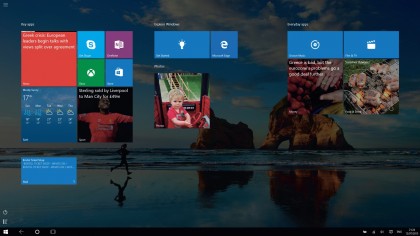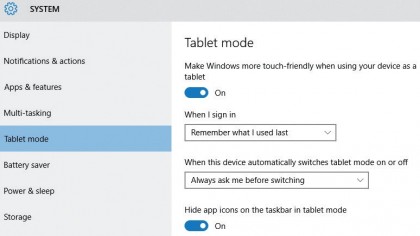How to use Windows 10's Tablet Mode
Adept at adapting
Windows 10 features several key usability features that make going into Tablet Mode a lot easier. Your device will automatically adjust for touch input and your desktop and Start Menu change. Windows 10 doesn’t go for a complete reintroduction of the Windows 8 Start screen, but it is kind of similar.
The Start menu becomes full screen, just like it was in Windows 8 and is permanently open on your desktop, so it's more like an iPad-style home screen launcher in the background.
If you've already used the Start menu in Windows 10, you'll know how much it's changed from the version in Windows 7. The new Start menu has live tiles on the right-hand side. You can right-click any file, folder or app in Windows and select 'Pin to Start' to include it here.

On the other side you get a list of recently used programs, as well as shortcuts to other key destinations, such as the Settings app and a shortcut to the File Explorer. You can also shut down, restart or put your PC to sleep from this menu, too; click 'Power' and another menu pops up with these options. The live tiles work in the same way as they do in Windows 8 so you can drag any of them around the menu should you wish to re-order them.
Tablet Mode introduces a modified version of this Start menu. The left-hand side of the menu now has three icons. The top 'hamburger' icon enables you to access your most-used apps. This part is more like the desktop version of the Start menu and your User Account is shown at the top – you can lock the screen or sign out here just as you could in Windows 8 and 8.1.
This menu is joined by a Power button (which enables you to restart, shut down or sleep) and another icon at the bottom so you can scroll down through a list of app your apps, not just the ones that are pinned to the Start menu.
In Tablet Mode, you can also swipe up on the left side to open the All Apps menu, so you can browse your entire apps list. Tap a letter on the All Apps list to go to a letter chooser and quickly jump to another section.
Are you a pro? Subscribe to our newsletter
Sign up to the TechRadar Pro newsletter to get all the top news, opinion, features and guidance your business needs to succeed!
If you're connected to a second display – which you might be with a convertible PC or tablet, such as the Surface Pro 3, the Start menu won't go full screen. Instead it will be the same size as normal and it also be constantly open. The other key thing Tablet Mode changes is how the Taskbar looks.
It becomes simpler in terms of features – although you can still get to everything you need. It spaces out the taskbar icons in the Notifications area and removes the ones you don't need (mostly unnecessary third-party icons). You just see Wi-Fi, battery, sound and the Action Centre icon left. Plus the ever-present clock, naturally. The App icons are hidden by default, too.
We're not sure why this is, but you can turn them back on if you wish. In fact, you can turn any Taskbar feature back on that Tablet Mode removes by default - the app icons, notification icons, touch-keyboard button and language switcher.
The touch keyboard icon disappearance is a bit of a strange one, but we guess the reason is the keyboard will still appear automatically if you tap into a text box, browser address bar or similar. So the button not being there isn't a huge issue.

What's more?
On the other side of the Taskbar, the Start icon is now joined by a back button, so you can cycle back to previous apps. If you were in the Start menu and then launched an app, tapping the back button takes you back to the Start menu. It's a much more phone-like experience.
There's also a Search icon as well as the Task View button. Search in Desktop mode (which incorporates the Cortana voice assistant) is via a search bar. In Tablet Mode it is an icon by default, offering a more simplistic look. Apps are full screen in Tablet Mode, whether they're Windows Apps you download from the Windows Store or traditional desktop apps, such as Microsoft Word.
This isn't as ridiculous as it sounds – we're all used to using tablet apps on things such as iPads, and Microsoft is trying to appeal to those sensibilities. It does take a little getting used to at first, however. In Tablet Mode you're also able to quit both desktop and new Windows apps in the same way you could in Windows 8; by dragging them down to the bottom middle of the screen.
Windows apps also have their X icon hidden for this reason (though if you happen to be using a mouse in Tablet Mode these will reappear). To move b between apps, Microsoft hopes you will use the new Windows 10 Task View feature. Using Task View is a lot more intuitive on a touchscreen device.
On a laptop or desktop, Task View is rather secondary to just switching between open icons on the Taskbar or using Windows with the Tab button ([Alt]+[Tab] still works as well, as you'd expect).
Task View is a fine new addition to Windows 10. However, you can't say it's a groundbreaking new feature, as it's mostly a repackaging of what has gone before. But what is new is its addition to the Taskbar. This brings it to the attention of more users. Until now, many people who used Windows wouldn't have even realised that pressing the Windows button with the Tab one could even take them to an interface to flick between apps.
Fewer still will have realised there was a way in the touch version of Windows 8 (not 8.1) to switch between app screen - flicking in from the left of the screen brought up a switcher menu. As with the Charms menu on the other side, it was underused and is now long gone, so it's good to have an even better feature to replace it with.
But, it's not true to say that Task View doesn't have any new features, since Task View also includes a Multiple Desktops feature (though it's only available in Desktop mode). While this is a new feature to Windows, it's not a new feature to computing in general; for example it's been featured in Apple's OS X operating system for several versions.
Multiple Desktops are intended primarily for work, where you might have your email open on one screen, a spreadsheet on another and so on. To prevent distraction, you can open different apps on different desktops, so you can move between the desktops using Task View and close the extra desktops when they're no longer needed.
Snap to it
Another change to app behaviour in Tablet Mode is the way you snap apps to the sides of the screen. As was possible in the Windows 8's Start screen, you can pin two apps side-by-side in Tablet mode. And as in Windows 8.1 (but not original Windows 8) you can adjust the split.
Simply drag the bar that runs down between the two apps. Aero Snap in Windows 10's desktop mode now enables you to do a four-way split, but you can't do this in Tablet Mode (we really like the capability to do it in Desktop mode, though).
If you used touch back during the Windows 7 days, you’ll know that using a touchscreen with the desktop isn’t the best time in the world. It was really hard to hit the target you wanted with your finger, and it just wasn’t a good experience. Windows 10 is much better, though, and there’s little to no uncertainty in touch.
Part of this certainly comes down to better touchscreen tech available these days. But, Microsoft has also been hard at work making the desktop an environment where touch can thrive, rather than be ‘second best’ to keyboard and mouse.
Tablet and 2-in-1 devices (with a detachable keyboard) are still in the minority when it comes to the number of Windows devices out there, and it's hard to see that changing in the short term.
That's why Windows 8 was such a mistake for Microsoft; it went too far towards catering for touch-based PCs that are a small percentage of all the Windows devices sold. And that's also why Tablet Mode is such a great addition for Windows 10. It's there when you want it and gone when you don't.
And for those of us with hybrid tablet/laptop devices detaching the keyboard and transitioning to Tablet Mode is a seamless experience. No longer is it just a case of the hardware being touch-ready, now Windows is as well. With Windows 10, Microsoft has worked hard to bridge the gap between desktop use on traditional PCs and tablets and it has succeeded.

Tablet Mode settings
Tablet mode can be automatic when you detach a keyboard, but it doesn't have to be. Within the excellent new Settings app, go to 'System', then 'Tablet Mode'. You'll see a toggle switch to switch Tablet Mode on or off, but it's the settings underneath that are more interesting.
You can choose what you want Tablet Mode to do when you first sign into your PC. Tell it to remember to switch Tablet Mode on or off depending on what you used last. Or select to always go to the Desktop or to automatically switch to Tablet Mode (so if your PC detects a keyboard it still won't switch).
The option below this enables you to control how automatic Tablet Mode is. You can make it automatic when a keyboard is detached, or you can choose to be prompted via a pop-up on the desktop. And finally, you can choose not to be asked and for it not to be automatic (but you can still invoke it manually).
- Enjoyed this article? Discover how to get the most from your PC and new things to do in Windows Help & Advice. Take advantage of an exclusive offer in our sampler today.